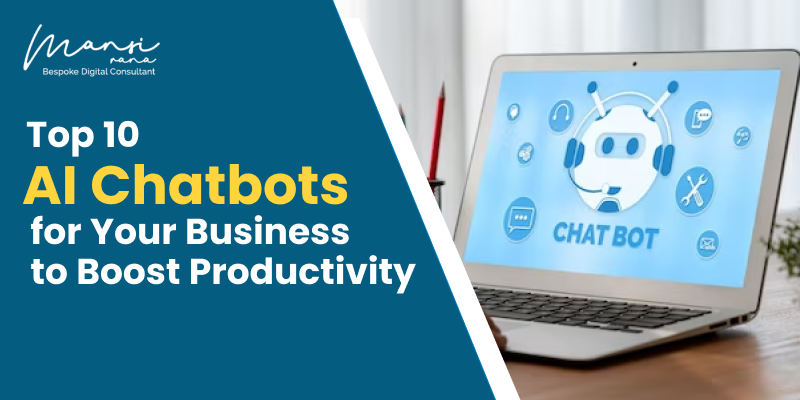
Top 10 AI Chatbots for Your Business to Boost Productivity in 2024
18 January, 2024
According to reports, around 23% of customer service businesses are actively using AI chatbots to boost productivity. In 2021, the global chatbot marketing revenue was $83 million and it’s all set to touch the mark of $454.8 million by 2027. In addition to this, some of the sophisticated AI chatbots can manage full customer conversations with an average success rate estimated at 69%. Reviewing the numbers, it can be stated with confidence that AI chatbots are surely going to prevail in customer service. By 2024, the business productivity will be increased through a greater contribution on their part.
If you are asking yourself- is it the right time to opt for AI chatbots for your business; then YES! With growing AI advancements and bots becoming both better as well as affordable, there is no reason why businesses shouldn’t use it to make a difference.
Since consumers are also adapting to chatbot interaction, businesses can do the same and implement round-the-clock customer service with no additional expense from their end. Actually, AI chatbots are not only bound within customer service but it could be applied in several business parts like sales and marketing to operations.
Besides, AI chatbots can be tailored specifically for the uniqueness and personal preference of one’s business. They are able to take on several tasks all at the same time, which makes for more projects that can be turned over quickly. It leaves your staff with more hours for other important activities. This in turn results in more productivity, efficiency and profit making.
The range of options available in the market can make you feel overwhelmed for making a choice regarding which AI chatbot is most appropriate for your business. To save your time, we have created a compilation of the 10 most successful AI chatbots with which business efficiency will achieve new heights in 2024.
1. Amazon Lex: An In-Depth Review
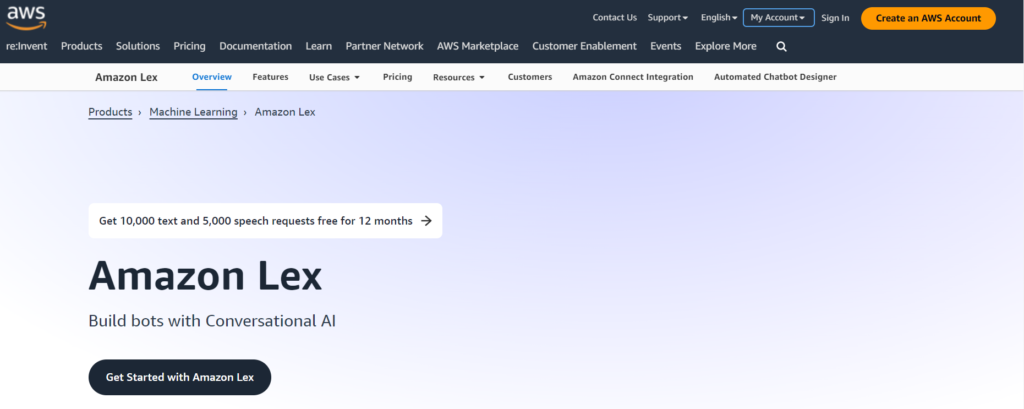
Amazon Lex is a comprehensive chatbot that helps to add conversational interfaces for almost all types of application using voice and text. Leveraging the same technology that powers Amazon’s virtual assistant, Alexa; Lex offers more advanced deep learning features for these two modules involving speech recognition and natural language understanding.
Features of Amazon Lex
- Automatic Speech Recognition (ASR): Through this service, Amazon Lex uses ASR to transcribe audible language into written text which makes it easier for applications that receive speech requests from users.
- Natural Language Understanding (NLU): This assists Amazon Lex in understanding what the user wants to achieve with text, hence responding accordingly.
- Multi-Platform Compatibility: The Amazon Lex can be integrated into mobile apps, web-based application and messaging platforms which includes Facebook Messenger’s API for developing chat applications or Twilio to create automated helpdesk systems.
- Easy Integration with AWS Services: It is seamlessly integrated with other AWS offerings such as lambda, Amazon Cognito and CloudWatch that provide an ecosystem for whole development.
- Enterprise-Ready: Amazon Lex allows multiple versions of the bot as well as supports aliases in order to easily manage environments such as development, testing and production.
Pros of Amazon Lex
- Ease of Use: Its user friendly environment allows developers to develop, test and deploy bots without being an expert in artificial intelligence or machine learning.
- Scalability: Amazon Lex is highly scalable, which allows it to be integrated not only into smaller systems but also larger ones.
- Cost-Effective: You have no minimum charges or upfront fees, you can purchase the text requests that are used from your balance.
Cons of Amazon Lex
- Limited Language Support: In its current state, Amazon Lex is a model that can only process English and the six languages of definite modern interest — Spanish, French, Italian, German, and Brazilian Portuguese.
- Dependency on AWS: The integration of Amazon Lex with several other AWS services also makes it difficult for a future change to another platform.
- Limited Customization: Although Amazon Lex is user-friendly, it may not be customizable enough for some developers looking to use voice features in an application that would be decidedly more specific to certain operations.
2. HubSpot Chatbot: A Technical Review
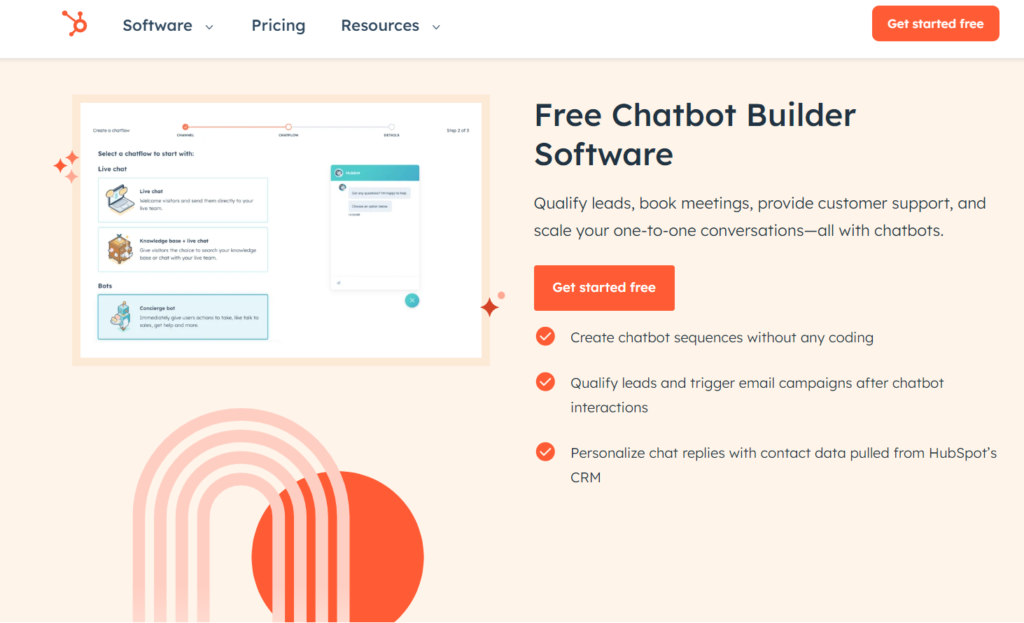
HubSpot has its own robust and versatile AI tool by the name of ‘conversations’ which has evolved to become a chatbot designed for automation and streamlining user interactions across all business scales. It uses artificial intelligence and machine learning technology to enable real-time individual audience interactions.
Key Features of HubSpot Chatbot
- Personalized Communication: HubSpot’s Chatbot has the ability to notify anyone with their specific details by using a personalized message from the CRM database. It is possible to have more relevant customer experience through such engagement.
- Automation of Tasks: Chatbot can perform automated tasks such as scheduling appointments, answering frequently asked questions and lead qualifications saving the sales or customer service team’s time.
- Integration with HubSpot CRM: By integrating the Chatbot with HubSpot CRM, it can easily fetch customer information while chatting and records details of chat on a conversation basis into the system.
- Customizable Templates: HubSpots offers flexible bot templates for numerous scenarios, which means you will be able to adjust your chatbot in accordance with the specific needs of a particular business.
- Conversational Flows: The dialogue capabilities of the Chatbot are complicated, so it can help users to pass numerous steps.
Pros of Using HubSpot Chatbot
- Efficiency: The Chatbot makes customer interactions more efficient by automation of repetitive activities that lead to decreased response time.
- Scalability: One of the benefits that make Chatbot scalable for any growing business is its ability to manage a large number of simultaneous conversations.
- Ease of Use: Working with HubSpot to create chatbots is easy due to its friendly user interface and ready-made models that can be adjusted according to one’s needs.
Cons of Using HubSpot Chatbot
- Limited AI Capabilities: Even though the Chatbot utility in HubSpot can deal with scripted scenarios well enough, it might fail when dealing with unscripted questions or challenging customers’ requests.
- Dependency on HubSpot Ecosystem: The Chatbot’s high-level integration with HubSpot CRM brings both benefit and drawback. Although it enables smooth syncing of information, if you select a different CRM later on, this could present issues.
- Cost: Although the free package of HubSpot includes available chatbot functionality, advanced level features are locked behind premium subscriptions forcing small businesses and new start-ups working on constrained resources to shy off.
3. ManyChat:
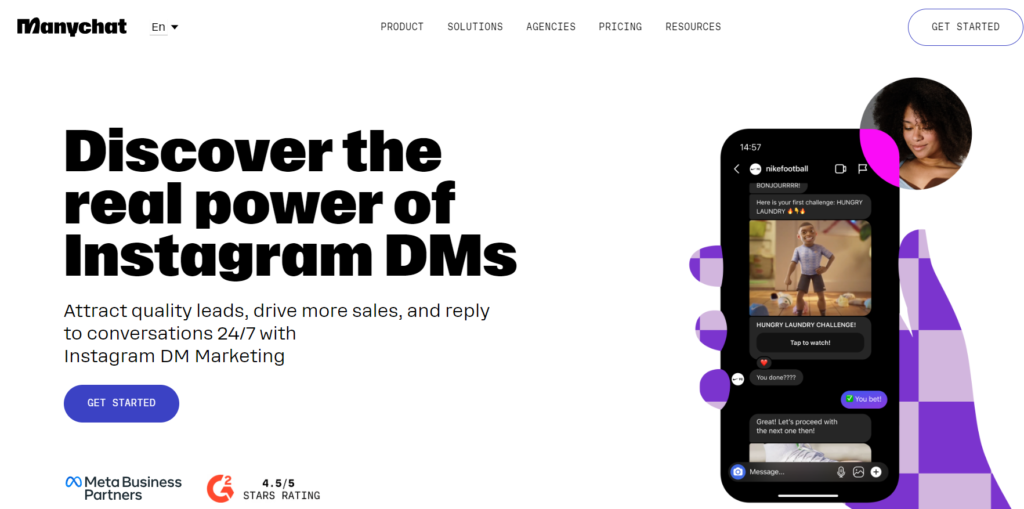
ManyChat is a tool used in the development of chatbots for Facebook Messenger and SMS. Its goal is to foster an automated but personalized approach towards a relationship between businesses and customers. It also allows using a visual builder, which is convenient for users with no coding background to create and launch chatbots within minutes.
Features of ManyChat
- Chatbot Builder: Chatbot Builder: ManyChat provides a friendly interface and attractive to work with, allowing creating the chatbot. With a drag and drop option, users can easily create a chatbot without any coding information.
- Templates: ManyChat has a wide selection of ready-made templates that are designed to meet several business objectives. These templates can be adjusted as per the needs of a particular business.
- Audience Segmentation: Through ManyChat, businesses are able to divide their audience by behavior, demographics and other parameters as well. This helps in focused communication and better conversion of customers.
- Broadcasting: Companies are able to communicate with customers on a large scale through messages that they may use for giving feedback or sending content like brochures.
- Analytics: ManyChat offers analytics that makes it easy for enterprises to track and understand user conversations, key metrics, as well as scopes of improvement.
Pros of ManyChat
- Ease of Use: ManyChat has an easy-to-use interface that enables any person to develop and use chatbots.
- Integration: The tool supports a great number of apps and services, such as Shopify, Google Sheet or Zapier etc., which makes it usable for any kind of business.
- Customer Support: The company provides a solid support system that consists of a knowledge base, chat with live agent and user community forum.
Cons of ManyChat
- Fewer Customization: Although ManyChat provides various templates, users may consider such a solution too restrictive if they have complex workflows in mind.
- Pricing: The free model of ManyChat has some constraints in functionality but other packages come at a cost.
- Dependence on Facebook: With ManyChat being mostly a Facebook Messenger tool, businesses that do not actively use this platform may find little value in this platform.
4. Drift:
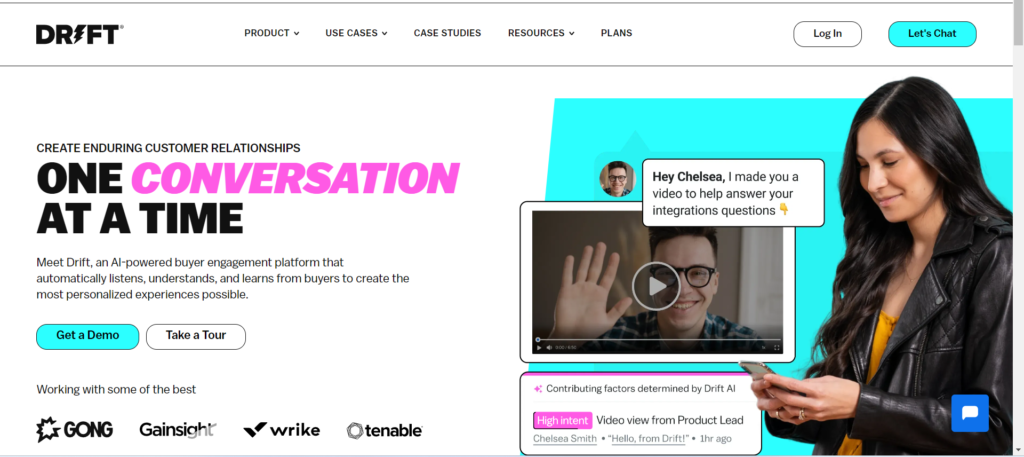
Drift is one of the most significant conversational marketing platforms which has transformed the entire customer interaction in this digital era. It utilizes AI to make sure that customer conversations are instantly improved with better user experiences. Below are the main features of Drift and its pros and cons.
Key Features
- Live Chat: Drift includes a live chat feature that businesses use to connect with their web visitants instantly. This function ensures quick communication, which would assist in answering customer questions quickly by firms.
- Chatbots: The chatbots in Drift are AI-powered ones, used to communicate with customers round-the-clock. Such chatbots may be programmed to answer simple questions, arrange meetings and even fill out leads so that your sales team doesn’t have to spend its day on these routine tasks.
- Email Marketing: The email marketing tools of Drift allow companies to send tailored emails that are based on the actions taken by a user. These tools enhance the level of engagement rates and conversions.
- Integration: Drift offers smooth integrations with a variety of third-party apps including CRM systems, email marketing software and social media platforms. This enables businesses to rationalize processes, speed up production and become more efficient.
Pros
- Improved Customer Engagement: The fact that Drift provides both a live chat option and automated chatbots enables constant communication with customers which improves satisfaction rates.
- Automation: The application of AI in addressing customer concerns and qualifying leads make it unnecessary to do manually which safeguards your human resource that could then attend more crucial leads.
- Personalization: When using Drift, companies can provide tailored experiences by observing user actions which increases satisfaction and loyalty to the customers.
Cons
- Learning Curve: Regarding its list of features and capabilities, Drift may be overwhelming to a beginner. It takes some time and training to grasp all its features.
- Pricing: The pricing issue may be a disadvantage for small companies or startups willing to adopt Drift features. Although it provides a free account, many features are stripped away and premium plans can get very pricey.
- Customer Support: Some of these users say that it takes longer to access support from Drift. This is problematic when businesses are faced with challenges or need help.
5. ADA Chatbot
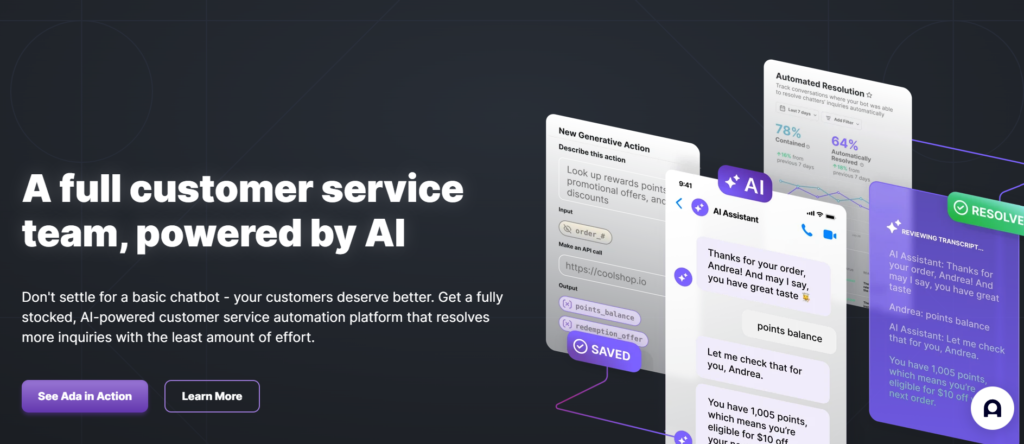
With the growing popularity of Al in many industries, businesses are taking advantage of it to enhance their operations and make customers satisfied. One innovation brought about by AI is ADA-Chatbot, or simply the ADA bot. In this case, let us look at the characteristics of advanced technology, pros and cons.
Features of ADA Chatbot
- Natural Language Processing (NLP): ADA chatbots have NLP, which allows them to process and analyze natural language. These can understand the text-based inputs they get, process them and act as per their analysis.
- Machine Learning (ML): ADA’s chatbots constantly learn after every user interaction and their responses get better as time progresses. They adopt ML algorithms to understand patterns and behaviors, thereby implementing individualized answers.
- 24/7 Availability: Unlike human agents, the ADA chatbots are active 24/7 hence guarantees customers consistent support.
- Automated Tasks: They can automate routine tasks like replying to FAQs, scheduling appointments or notifying others.
Pros of ADA Chatbot
- Cost Efficiency: The chatbots developed using ADA help businesses reduce operational costs as they are able to attend to many queries at the same time which means that a business does not need a huge customer service team.
- Enhanced Customer Experience: Availability, immediacy of response and personalization that ADA chatbots offer leads to much effectiveness in customer services.
- Data Collection: They can gather and analyze the data that come from customer interactions with them, such insights may be used as means of growing one’s business.
Cons of ADA Chatbot
- Limited Understanding: In spite of advances in techniques and models for natural language processing (NLP) applications, chatbots may still have difficulties working with complicated queries or inaccuracies present within the flow as part of human speech.
- Lack of Human Touch: Although ADA chatbots are able to imitate a dialogue, they do not possess the emotional intelligence of live agents. This can help tailor the client experience in delicate situations, but may also deliver less satisfactory results.
6. Avaamo.ai
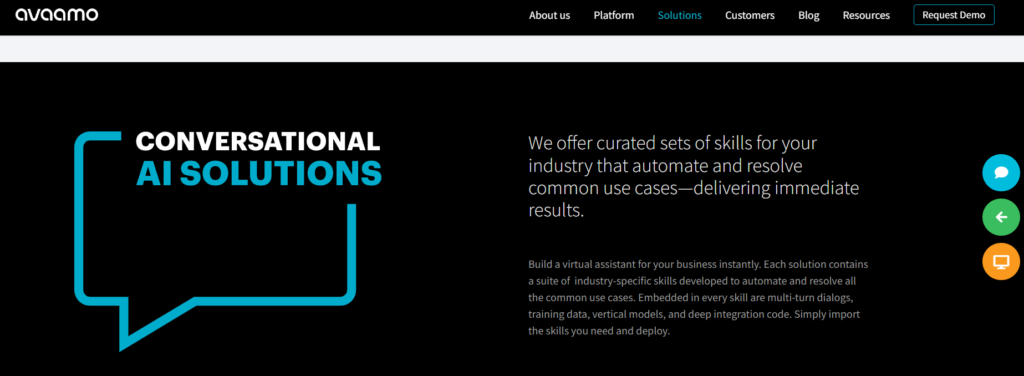
Avaamo.ai is one of the finest enterprise conversational AI platforms that deploys techniques and models such as machine learning, deep learning to automate business processes. It is a robust tool that presents profession-specific competencies so it can help businesses to utilize AI-based amenities. In addition, Avaamo.ai has multi-channel support that covers all voice channels along with chat and messaging platforms.
Key Features of Avaamo.ai
- Industry-Specific Skills: Avaamo.ai offers industry-specific skills that were designed to automate and solve all business operations, which makes it a universal solution for different sectors.
- Advanced AI Technology: Avaamo has been at the forefront in developing core AI technologies spanning a wide area of brain powernets, synthesis and deep learning that seek to democratize conversational computing.
- Integration with Legacy Enterprise Workflows: The Avaamo platform’s integration with conversation design plus to legacy enterprise workflows allows businesses to add AI capabilities into their existing systems.
- Multilingual AI Platform: With Avaamo’s multilingual AI platform, companies are assured that they will be able to reach a diversified market segment.
Pros of Using Avaamo.ai
- Quick Deployment: Avaamo’s artificial intelligence platform utilizes a conversational AI model that would reduce the time taken to design and launch virtual assistants within an enterprise, Ease of digital transformation.
- Automation of Conversations: The purpose of Avaamo is to automate every conversation that would be possible between an end-user and the enterprise, improving customer service and cutting operational costs.
- Highly Rated by Users: The overall user satisfaction is high judging by feedback on Avaamo Conversational AI Platform gathered from real users vetted by Gartner Peer Insights.
Cons of Using Avaamo.ai
- Potential Complexity: Like other high end AI platforms, there is a learning curve that some users may have to acclimatize themselves with first since they did not come across AI and machine language applications.
- Integration Challenges: It is possible to integrate Avaamo.ai with legacy systems, but the process of integration may be complicated and especially difficult in relation to outdated interface, storage and processing structures.
7. Watson Assistant
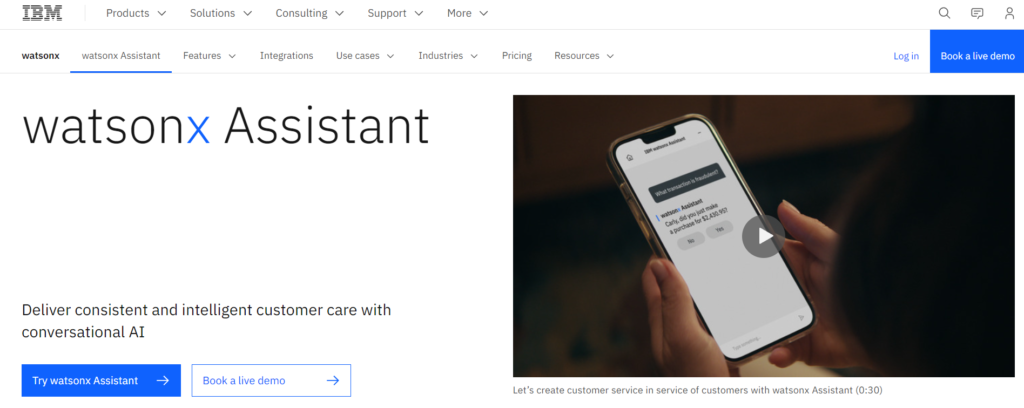
The Watson Assistant is a conversational AI platform for creating, training and deploying powerful bots that deliver vital customer experience information to businesses. Such businesses that require a platform which has strong AI propositions, large knowledge base and solid integration options can opt for Watson Assistant. Additionally, the reputation of IBM as an AI and machine learning technology leader builds further trust on the platform. Regardless of the size of your business, Watson Assistant can offer you everything that is required for improving customer experience and boosting productivity.
Features of Watson Assistant
- Contextual Understanding: First and foremost, Watson Assistant utilizes Natural Language Processing (NLP) to capture the meaning of a query posed by an individual helping it provide meaningful responses.
- Dialog Skill: It enables developers to create dialog flows, configure intents and entities as well as keep track of dialogs’ states.
- Integration Capabilities: Watson assistant can be deployed across several channels, websites and Mobile apps, message platforms or even IoT devices.
- Multi-Language Support: It is multilingual which makes it a solution aimed at the global level for business.
- Training: The system is capable of being trained with the help of industry jargon and phrases and its enhanced learning approach that enables it to learn from each interaction makes him sharp in performance.
Pros of Watson Assistant
- Scalability: Watson Assistant is capable of processing multiple queries in huge volumes simultaneously thus can be expanded to meet the needs of any business.
- Customization: Businesses have the freedom to tailor their assistant based on specific requirements.
- Privacy and Security: Watson Assistant offers privacy and security of data because it does not train its models using customer’s information.
- Ease of Use: Despite being a complex system, Watson Assistant is intuitive and straightforward to install.
Cons of Watson Assistant
- Complexity: Even though the Watson Assistant is easy to use, some technical skills may be needed for one to take full advantage of its features.
- Limited Pre-Trained Models: As of now, the number of pre-trained models available for direct use are limited.
8. Infobip Chatbot:
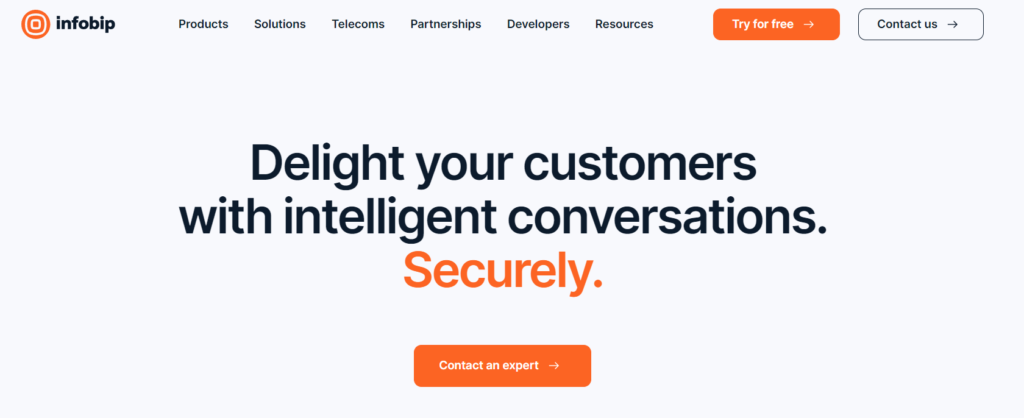
Infobip is a global cloud communication company behind a robust chatbot platform that can change how companies communicate with their clients. One of the major strengths that Infobip boasts is its omni-channel capacity as far as utilization in the Infobip Chatbot area is concerned. It can also be easily integrated with multiple communication avenues such as SMS, email, social media networks including messaging platforms and voice assistants.
Features:
- Omnichannel Support: Infobip chatbot allows for integration in different communication channels such as WhatsApp, Facebook Messenger, Viber and others. It means businesses can meet their clients where they are at ease.
- Automated Customer Service: The chatbot can respond to routine customer questions allowing human agents handle the complicated issues that require more concentration. This will cut response times and boost customer confidence.
- AI and Machine Learning: Essentially, the Infobip chatbot uses AI and machine learning tools to be able to comprehend customer queries better while being able to converse naturally.
- Integration & Customization: It is a highly adaptable solution that can seamlessly work with current systems and meet business requirements.
- Analytics Dashboard: Infobip offers an in-depth analytics dashboard that measures chatbot performance and customer interaction data which lets business users act on their decision based on data.
Pros:
- 24/7 Availability: This means that customer questions are quickly answered at all times of the day or night regardless of which part of the world they come from.
- Scalability: Infobip chatbot is capable of processing many requests at once that makes it suitable as a scalable option for customer service.
- Cost-Effective: The chatbot enables businesses to minimize operating costs incurred in customer service by automating repetitive tasks.
- Improved Customer Engagement: Due to natural language processing, the bot is able to achieve better reaction with customers on a more personal level.
Cons:
- Dependency on the Internet: One of the limitations with this chatbot’s features is that it works well depending on the connection to the internet. Network problems also cause service disruptions.
- Impersonal Interaction: Even though chatbots continue to evolve, customers prefer that their inquiries be handled by humans because they find the former too impersonal.
9. DialogFlow
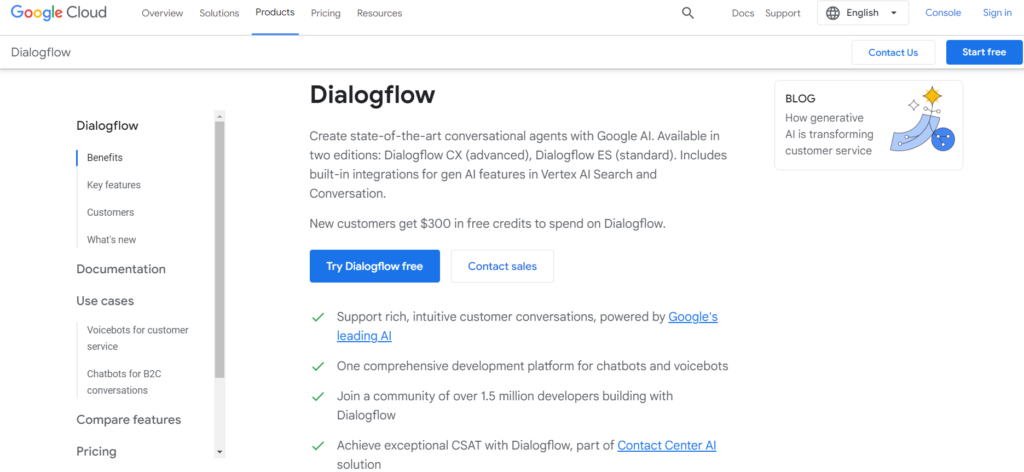
The product developed by Google DialogFlow is a very powerful platform intended to build conversational and smart chatbots. It has a simple to use CUI designer that users can create and deploy across mobile apps, web applications, devices as well as Bots. Additionally, DialogFlow has many other integrations with message platforms like Facebook Messenger, Slack and Twitter among others allowing businesses to use it as a versatile solution aimed at boosting customer service quality.
Key Features of DialogFlow:
- Natural Language Understanding (NLU): DialogFlow uses Google’s machine learning and natural language understanding features to enable it to understand human linguistics as a human would in conversation.
- Cross-Platform Compatibility: It can also be integrated into a multitude of platforms, including Google Assistant, Facebook Messenger, SMS Slack and Skype Twitter.
- Multi-Language Support: DialogFlow offers support for more than 20 languages, this enables developers to build bots that can communicate with people from different linguistic groups.
- Training and Machine Learning: The platform is always learning and getting more accurate over time based on user interactions.
- Context Handling: This tool could retain the context of dialogues, so it was able to work in a more complex setting and remember what has been discussed before.
Pros of Using DialogFlow:
- Ease of Use: Dialog Flows user-friendly UI is perfect for creating, testing and launching chatbots on the market.
- Robust Documentation: Google has vast documentation as well as available resources and this is encouraging the developer to understand and use it better.
- Powerful NLU Capabilities: The NLU engine of Dialog Flows can process intricate requests and give an accurate meaning to the questions.
- Scalability: Since DialogFlow is a Google product, it comes with optimum scalability feature which makes it fit for small to enterprise-size applications.
Cons of Using DialogFlow:
- Limited Customization: The disadvantage of DialogFlow is its restricted customizability options despite the user-friendly interface, so it may not fit in complex systems.
- Complexity in Handling Large Conversations: Though DialogFlow performs well with smaller interactions, it tends to struggle when dealing with large amounts of conversation which proves complex.
10. Bold360:
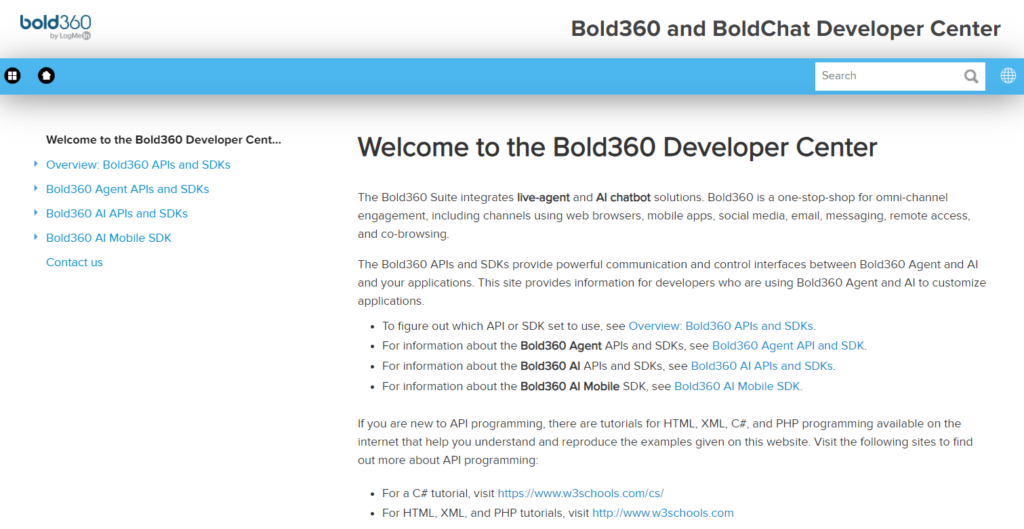
Bold360 is an eminent customer engagement and AI software that incorporates live agent and chatbot solutions. It is meant to provide handcrafted experiences through various channels, such as chat, messaging etc. This solution takes advantage of sophisticated artificial intelligence and machine learning technologies to ensure automated adaptive communication between a company’s clients. Whatever your direction − whether it is strengthening of customer service, improvement in sales results or optimization of a visitor’s impression on the general company level – Bold360 handles everything.
Features of Bold360:
- AI-Powered Support: Bold360 uses AI to generate a modern help center in which customers can serve themselves through the use of search bars. It is powered by patent pending technology of Contextual-Answers and intellectual property rights based Natural Language Processing for advanced support chatbot solutions.
- Omni-Channel Engagement: Bold360 provides an all in one omni-channel engagement solution. It runs on multiple web channels in order to give customers a smooth process.
- Personalized Experiences: Bold360 is AI-driven in its delivery of tailored experiences across diverse channels.This enables businesses to engage their customers in a more targeted way.
- Comprehensive Dashboard: Bold360 provides a complete control dashboard that includes detailed reports of customer engagements and service.
Pros of Bold360:
- Comprehensive Solution: Bold360 is a complete package that stands among some of the best AI and live chat platforms available. It integrates conversational AI and live chat along with customer engagement components, service functions.
- Improved Customer Service: The Bold360’s AI that is integrated to its support system enables customers’ self-serve thus improving customer service experience.
- Integration Capabilities: This makes Bold360 a versatile platform since it can integrate with different web channels, which businesses may need if they are committed to enhancing customer engagement.
Cons of Bold360:
- Cost: One of the significant limitations associated with Bold360 system cost. It is among the costliest alternatives in the market. This may act as a limitation to small businesses or start-ups that the financial capability.
- Limited Customization: Though Bold360 provides personalization tools for customer experiences, the degree of customizability can be restricted to certain industries. This could limit further the incapability to entirely customize the chatbot according to specific business requirements.
FAQ
What is the best AI chatbot?
The ‘best’ AI chatbot is a subjective thing and varies on the individual user’s needs. Speaking technically, the best AI chatbot should have capacities such as the Natural Language Processing (NLP) technologies to interact with users efficiently and follow their queries, Machine Learning (ML) for adaptation in practice learning from interactions, and solid integration functionality ensuring easy cooperation across different platforms. Some of the most popular examples in this industry are Watson by IBM, Dialogflow by Google and Avaamo.ai. The selection of an AI chatbot should be based on the features and abilities that fit a specific use case. In addition, factors such as data privacy and security should be taken into account while planning long-term adoption.
What are the best free AI chatbots?
There are many free AI chatbots that come with great functionalities for various applications, although the majority of them have limitations in their case versions. Some of the most common ones include Chatfuel that is famous for its user-friendly nature and interactivity with Facebook Messenger, Snatchbot which provides a solid platform offering unlimited messaging as well as Wit.ai – voice interface service by Facebook aimed at various applications and devices. Mention must also be made about the Bot Framework by Microsoft that provides development of smart bots interfacing with different channels. While these AI chatbots are mostly offered for free, the type of services they provide is rather restricted in their unpaid versions that can be expanded on by opting to upgrade.
Is there a better AI than ChatGPT?
ChatGPT is created to produce some input related text similar to the way a human would. Moreover, its efficiency might depend on the conversational difficulty level, clearness of input and task specifics. Some may perform well in one kind of task and yet fail to deliver elsewhere. For example, GPT-3 which is the successor to ChatGPT has demonstrated impressive results in generating lengthier and more consistent replies. There are two more very good conversational models that one way or another could challenge ChatGPT; these include Bard by Google and Watson by IBM. The “better AI” ultimately comes down to the needs in question, and the best way of determining it is thorough analysis of not only tasks at hand but also all qualities required for such a task from an AI model.
What is the most intelligent AI chatbot?
There are some multiple AI models that remain prominent for their cutting-edge features. GPT-3 is developed by OpenAI and it is one of the most powerful language models capable of generating longer, coherent responses that look like human language. It is an advancement on its ancestor ChatGPT which has a widespread performance in different conversational settings and assignments. Other sophisticated chatbot models that have shown impressive conversational skills include Google’s DialogFlow and IBM Watson. If you need a robust bot to handle business intricacies, IBM Watson could be the best choice as it comes with several enterprise templates that are quick to integrate and use.
What is the best AI chatbot for personal use?
Sophisticated conversational models such as GPT-3, and Google Bard have been in high demand given their ability to deliver responses typical of humans. Nevertheless, their challenging characteristics and the technical skills needed to implement them properly could limit frequent easy access for individual users. However, user-friendly chatbots such as Replika have been developed with adaptation to personal use and interaction in mind providing users functions like emotional support, reminders, and having casual dialogue. On the other hand, Google Assistant, Siri and Alexa are more pragmatic in nature to provide services around voice-enabled commands; distribution of schedules or simple information recall.
What is the most powerful chatbot?
Among the leading competitors in terms of natural language processing and advanced AI models are GPT-3 developed by OpenAI, DialogFlow provided by Google, as well as IBM’s Watson – these have an excellent conversationalist factor with coherent replies. For individual use however dynamics changes it is now the time for more straightforward versions involving ease of usage. Even though GPT-3 shows impressive chatbot performance, it may not be suitable for casual daily usage as an outcome of their technological intricacies. Chatbots such as Replika, Google Assistant Siri and Alexa are preferred for normal personal use. They come with a variety of features such as the ability to act as reminders,process voice commands and more; they are also more focused on schedule management and basic data retrieval hence making them personalities within reach.
Is Google Bard better than ChatGPT?
As far as the performance or accuracy of tasks in natural language processing are concerned, both Google Bard and ChatGPT stand out. However, they are of different types and serve a variety of purposes. While Google Bard is a text generation model for producing creative outputs like song lyrics or poetry, ChatGPT focuses on conversational AI and enables the development of chatbots. In the long run, it really comes down to what type of assignment is present and how this AI model will be employed. Both Google Bard and ChatGPT have their own merits, which make them some of the top performing models in both branches. Also, the current rapid progress of AI technology may be evidence that newer and even more advanced models will overtake both Google Bard and ChatGPT quite soon.